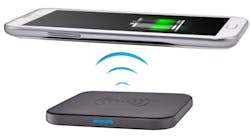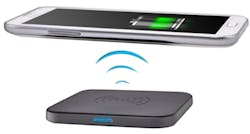Industry analysts' predictions on the value of the wireless charging market are becoming increasingly bullish with estimates claiming the global wireless charging market is expected to be worth €5.3 billion in 2017, a substantial rise from the 2011 value of €337 million.
Today, wireless chargers are supplied in a variety of guises but are still based on electromagnetic (EM) coupling whereby charging is enabled via EM fields. Currently, there are five wireless technologies: inductive coupling technology, RF technology, magnetic resonance technology, microwave technology, and optical beam technology.
But as is so often the case with burgeoning technologies, commercial progress of the wireless charging market is hindered by the absence of standards necessary to ensure compatibility between different providers and their technologies.
This file type includes high resolution graphics and schematics when applicable.
However, on a more positive note, it is certainly true that the wireless charging industry has numerous consumer-related application opportunities that it can exploit. These include charging of mobile phones (see photo) at wireless charging facilities in restaurants, cinemas, railway stations, airports, and many public areas. Not surprisingly, it is expected the increased use of wireless charging technologies by consumers during the next three years will create a global user-base of approximately 140 million units.
So a speedy and pragmatic finalization of industry standards that will allay consumers compatibility fears is an indisputable imperative.
There are in fact three standardization bodies jostling for a leading position in the wireless charging market. The Wireless Power Consortium (WPC) has established the Qi standard and has 180 industry members. It is a globally recognized standard and there are approximately 380 products that are certified as conforming to Qi.
Formed in 2012, the Power Matters Alliance (PMA) has about 100 members and is currently working on the formalization of its industry standard.
Finally, the Alliance for Wireless Power (A4WP), founded in 2012, has 60 members; the first products that meet the requirements of this standard are expected to be launched in 2014.
The standards from WPC and PMA are based on inductive charging and are therefore defined as tightly coupled systems. They are recognized as being more efficient than the alternative loosely coupled approach that employs resonant charging. However, as the name suggests, tightly coupled charging relies on the receiver and transmitter physically being within a few millimeters of each other.
The A4WP is an advocate for resonance charging, a technology with a distinct advantage in that it allows greater freedom of how units have to be positioned against the charging transmitter unit. It allows more spatial flexibility and could offer the advantage of being able to place numerous devices on a charging pad simultaneously. However, spatial freedom can hinder efficiency.
Reduced efficiency is a particularly important issue when it comes to wireless charging. Low efficiency would mean longer charging times and could exacerbate heat dissipation problems. It is generally accepted that tightly coupled wireless charging provides efficiencies higher than 70%, whereas loosely coupled wireless charging performs at 60%.
System safety is another significant concern. All wireless charging systems must have the capability to recognize foreign objects in order to avoid potentially hazardous heating of metal-based objects that are inadvertently positioned on the power transmitter. As a result, foreign object detection (FOD) becomes an essential design element.
Therefore, emerging standards from the various industry bodies not only need to define the myriad of electrical and electronic specifications required for wireless charging compatibility. They must also formalize and implement precise and sustainable communication and safety criterion.
As in any sphere of electronics, there is inevitably a standards battle when it comes to emerging technologies, as demonstrated by the Betamax versus VHS and the Blu-Ray versus HD-DVD skirmishes in commercial television markets. Predicting the wireless charging standard that will emerge as all-conquering at this stage of development is tricky, because each standard organization is concentrating on different technological approaches.
This file type includes high resolution graphics and schematics when applicable.


